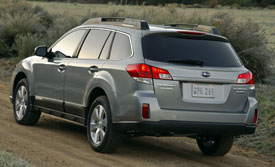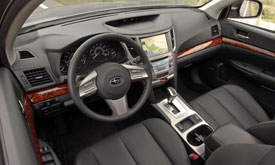2010 Subaru Outback
It was 1996 when Subaru decided to combine station wagon “garagability” with outdoorsy car-like utility. The Legacy Outback became known as “the world’s first sport utility wagon” and helped launch a new category of vehicles called crossovers. Since that time, mainstream crossovers have saturated the market, but the Outback has retained its unique and sporty wagon appeal, not to mention a growing fan base.
For 2010, the Subaru Outback enters its fourth generation and undergoes a full redesign. While Legacy is no longer part of its name, the Outback still shares its new platform with the sedan. This 5-door is wider, taller, yet a hair shorter than before. Wheelbase gains almost 3 inches to 107.9, yielding a larger interior.
And the new Outback isn’t just stouter, it’s more rugged-looking, while also taking cues from the new Legacy. The front end starts with a more upright grille, flanked by expressive-looking hawk-eye headlamps. On profile, scuff-resistant lower rocker moldings and body cladding further convey the Outback’s enhanced capability.
But this is no poser. With 16- and optional 17-inch wheels, ground clearance edges up to 8.7 inches, giving it more off-road potential than many crossover rivals. Up top are standard roof rails, with crossbars that swing into position only when needed, a segment first that helps minimize wind noise.
 The body-colored D-Pillars help emphasize the new sectioned taillights, and give the Outback a more traditional rugged utility look than before.
The body-colored D-Pillars help emphasize the new sectioned taillights, and give the Outback a more traditional rugged utility look than before.
Hands-down, this is the roomiest Outback cabin to date. It’s also decidedly more upscale. Like Legacy, the dash is comprised of a variety of dissimilar shapes, well-drawn lines, and metallic trim.
Controls are laid out in a smart, easy-to-use manner. Ditto the standard electronic parking brake with hill holder, the first among non-luxury crossovers. And, with green motoring in mind, there’s even a gauge for monitoring fuel economy.
Seats are nicely contoured and padded for a high level of comfort. Our test 2.5i Limited had leather trim, 10-way power adjusters for the driver, as well as seat heat. A tilt/telescoping steering wheel with audio and cruise is now standard. This up-level tester also came with Bluetooth, dual-zone climate control, and a 440-watt Harmon-Kardon audio system. Other available high-end amenities include voice-activated navigation, a rear-view camera, and a power moonroof.
The spacious rear seat makes ample room for three and offers a new recline feature. The 60/40 fold adds excellent versatility to the Outback’s abundant cargo space. Room behind the 2nd row swells from 34.3 cubic feet to 71.3 with seats folded down. That’s a gain of 6 cubes over last year, and more than a Jeep Grand Cherokee. A pair of all-wheel drive boxer powertrains are also shared with the new Legacy.
 Standard is a revised 2.5-liter single cam four-cylinder with i-Active valve lift, outputting a square 170 horsepower and 170 pound-feet of torque. It pairs to either a six-speed manual or a CVT automatic.
Standard is a revised 2.5-liter single cam four-cylinder with i-Active valve lift, outputting a square 170 horsepower and 170 pound-feet of torque. It pairs to either a six-speed manual or a CVT automatic.
The 3.6R adds the Tribeca’s 3.6-liter 6-cylinder powerplant. This one sends 256 horses and 247 pound-feet through a 5-speed automatic.
Our 2.5 CVT generated Government Fuel Economy Ratings of 22 city/29 highway on regular gas. We achieved the expected 24.7 in real world driving.
The Energy Impact Score is a modest 14.3 barrels of oil consumed per year, while its Carbon Footprint measures a tidy 7.7 annual tons of CO2.
The downside to this environmental awareness is the long 10.1 seconds needed to get to 60 miles per hour. The quarter mile was equally painful at 17.8 seconds at 79 miles per hour. You can feel the boxer’s torque, but the CVT acts like a fire blanket.
The Outback sports a new double-wishbone rear suspension, and stability and traction control are now standard across the board. Still, handling is also no strong suit. Softly sprung, there’s very little feedback through the chassis. Steering is numb and lazy, and the high center of gravity results in lots of sway and body roll.
The Outback’s brakes are 4-wheel discs with ABS and new Brake Assist. Stops averaged a longish 133 feet from 60 to zero. There was good stability, but the Outback still stops like a much larger vehicle.
Fortunately, what the Outback lacks in track performance, it more than makes up for with a smooth, comfortable ride. It’s nice and cushy for long road trips and extended commutes. Pricewise, the new Outback begins at $23,690 for the base 2.5i. The 3.6R starts at $28,690.
The 2010 Subaru Outback returns with a bolder outer show, more utility-like practicality, and plenty of interior refinement. It’s not much of a driver’s car, but it’s ideal for family carting and an outdoor lifestyle. Add in mid-twenties fuel economy, and the Outback becomes an excellent alternative to the conventional crossover-and the main reason, we believe, that Outback’s popularity is bound to keep growing.
Specifications
- Engine: 2.5-Liter Single Cam Four-Cylinder
- Horsepower: 170
- Torque: 170 Lb Feet
- 0-60 MPH: 10.1 Seconds
- 1/4 Mile: 17.8 Seconds @ 79 MPH
- 60-0 MPH: 133 Feet
- EPA: 22 MPG City/ 29 MPG Highway
- Mixed Loop: 24.7 MPG
- Energy Impact: 14.3 Barrels Oil/Yr
- CO2 Emissions: 7.7 Tons/Yr
2025 Volkswagen ID. Buzz
Volkswagen Brings Beetlemania Level Of Excitement To Minivan Segment
The duty of upholding Volkswagen’s heritage has most recently been delegated to small legacy car names like Golf and Jetta. But hold on! A much larger, totally modern take on VW’s classic microbus has just buzzed over the horizon— the all-electric ID. Buzz. It’s been at the top of our minds since we first saw the concept back in 2017. Well, it’s finally here, so let’s get our groove into drive!
This 2025 Volkswagen ID. Buzz has indeed created the most buzz around Volkswagen since the Beetle’s return to the U.S. in the late 1990s. We couldn’t drive it anywhere without drawing a crowd. No wonder, just about everyone has a VW Microbus story to tell, and seeing this reimagined version rolling down the street brings back all those memories.
VW really pulled it off as far as we’re concerned, as it looks great without appearing over the top. All the cues are here: Big VW logo front and center, lots of greenhouse including A-pillar windows and mini sliders for the second-row passengers, D-pillar air vents, and two-tone wheels. And while its appearance may be pure retro, its drivetrain is far from it, as the ID. Buzz is all-electric, and unlike the new Beetle, the Buzz does retain the original Microbus’ rear-drive architecture.
Powering those rear wheels is a 210-kW motor drawing juice from a 91-kWh battery for a range of 234 miles; 200-kW max charging will get you to 80% in about 26 minutes. Buyers can add another small 80-kW motor up front for 4motion all-wheel-drive and an increase of total output from 282 to 335 horsepower with a combined 512 lb-ft of torque. It uses the same battery, but range estimates drop just slightly to 231 miles. But while those numbers are modest, we also found them to be quite conservative, as we observed as many as 287 miles available in our all-wheel-drive tester’s gauge display and were on pace for 273 miles in our driving loop.
One throwback theme that may be a turnoff to some is that it’s quite a step up into the Buzz’s front seats, but there’s certainly a commanding view of the road once you climb in. Second row seating can be either a three-place bench or a pair of captain’s chairs, so there’s generous room for seven or six passengers. The captain’s chairs in our Pro S Plus offer good support and very easy access to the third row.
Lots of flexibility too with the option to simply fold the seats or remove them altogether.
With the sliding side doors and a wide opening rear hatch, there’s plenty of access for loading big sport utility amounts of cargo. Lots of flexibility too with the option to simply fold the seats or remove them altogether, and the ability to create a full-length flat floor with a rear cargo shelf that covers some handy removable storage bins. There’s 18.6 cubic-feet of space behind the third row, 75.5 behind the second, and a max of 145.5. That’s more than a Chevrolet Tahoe. For smaller items, there are lots of cubbies throughout the cabin, along with a standard Buzz Box that can be moved to multiple locations.
With a design that prioritizes retro form and modern function over aero efficiency, the 4motion equipped ID. Buzz earns a Fair efficiency rating, using 42-kWh of electricity per 100 miles, and we weren’t sure what to expect at our Mason Dixon test track.
What we found was great torque off the line and drama free launches to 60 in just 5.3 seconds. It was very stable at speed and power delivery stayed steady most of the way down the track until we reached about 90 mph, when it began to taper off just before we finished the quarter-mile in 14.0 seconds flat at 97 mph.
With 1,200-lbs. of battery weight nestled in its 127.5-inch wheelbase, the Buzz felt planted to the pavement through our handling course. There was quite a bit of body roll to deal with, but surprisingly little understeer. In panic braking runs, pedal response was inconsistent, feeling soft at times, pushing back hard at others; but through it all, results were quite good, stopping from 60 in an average of just 108 feet.
Three interior themes are available, this Dune is the brightest, featuring coastal inspired wood optic dash décor, “gray and clay” leatherette surfaces, and a high-mounted central 12.9-inch touchscreen. Pricing starts with a rear-wheel-drive Pro S at $61,545; this Pro S Plus begins at $65,045, add another $4,500 for 4motion, which brings a few extra features along with all-wheel drive.
Retro design with old-school VW charm, modern EV drivetrain, big SUV capacity merged with minivan flexibility; it all comes together in this 2025 Volkswagen ID. Buzz. It’s easily one of the coolest rides of the year and one that will likely keep Volkswagen dealers buzzing for years to come, and that’s something no other people and things mover can say.
Specifications
As Tested
- Motor Setup: Dual-Motor AWD
- Battery Size: 91-kWh
- Horsepower: 335
- Torque: 512 lb-ft
- EPA Range: 231 miles
- 0-60 mph: 5.3 seconds
- 1/4 Mile: 14.0 seconds at 97 mph
- Braking, 60-0: 108 feet
- MW Test Loop: ~ 273 miles













































